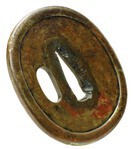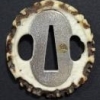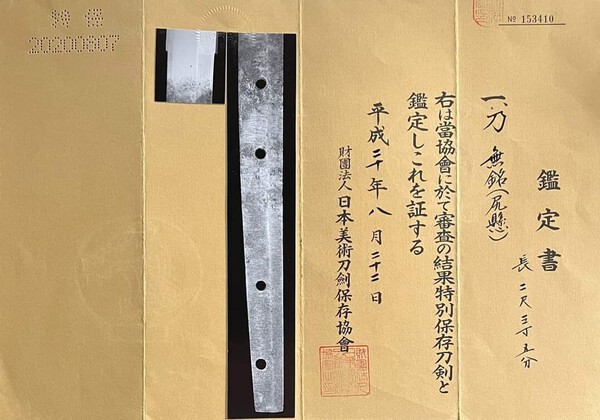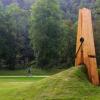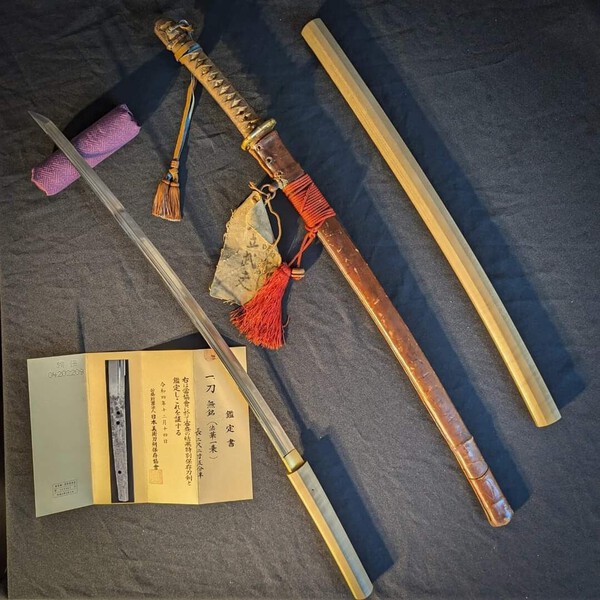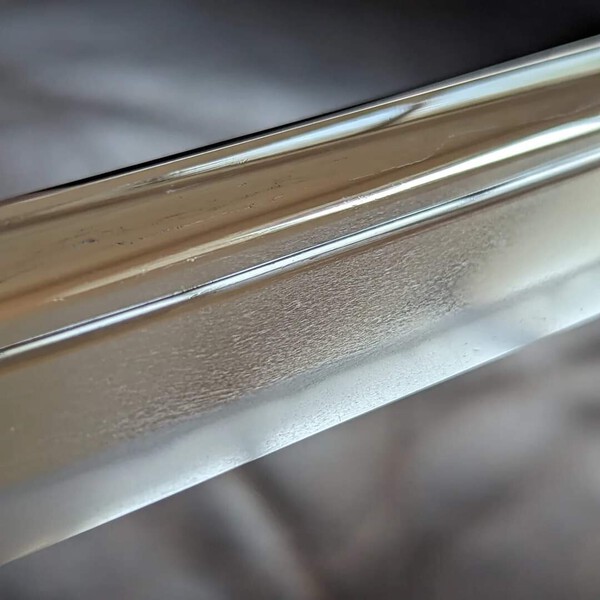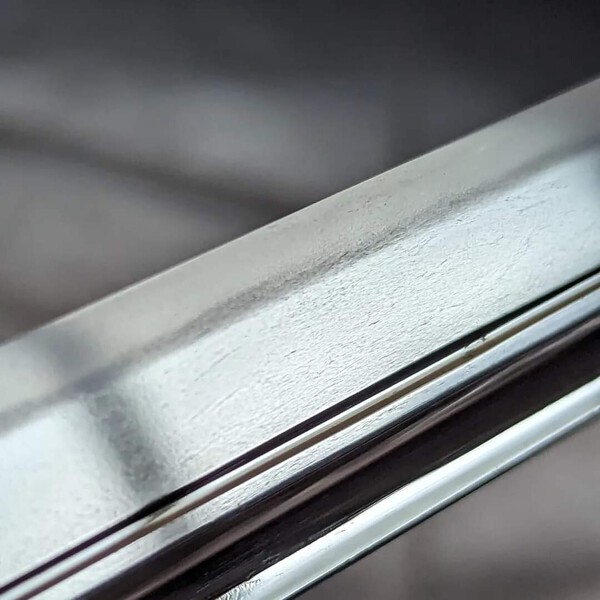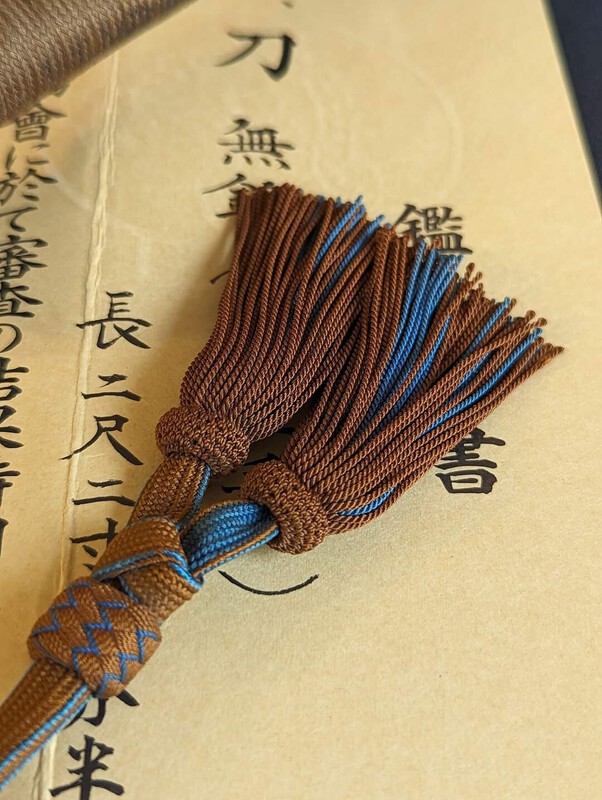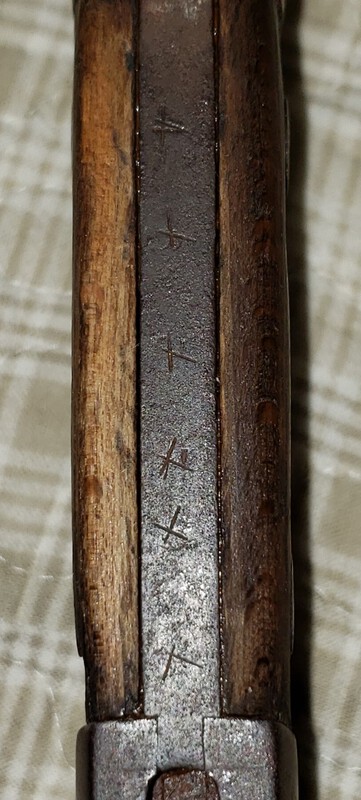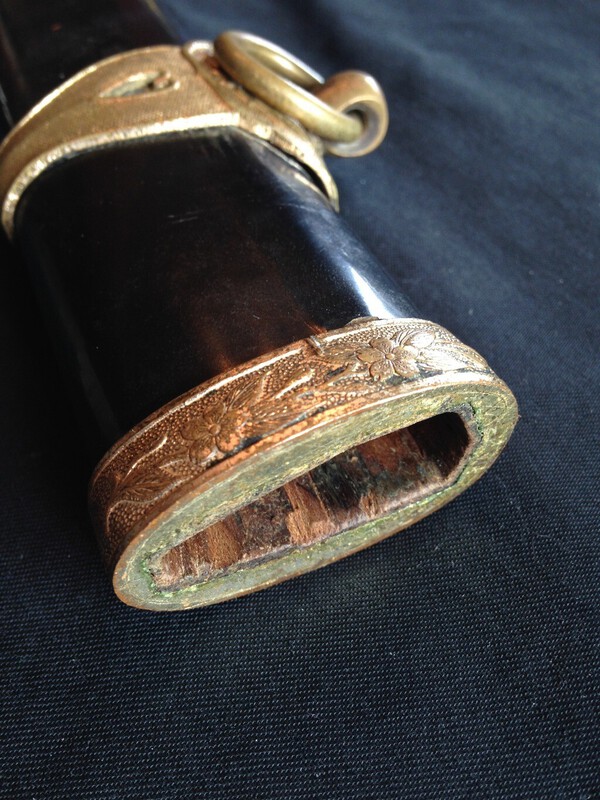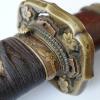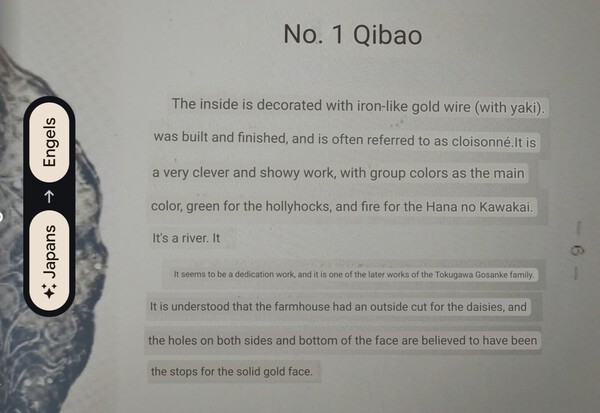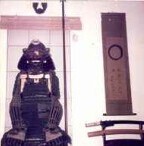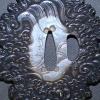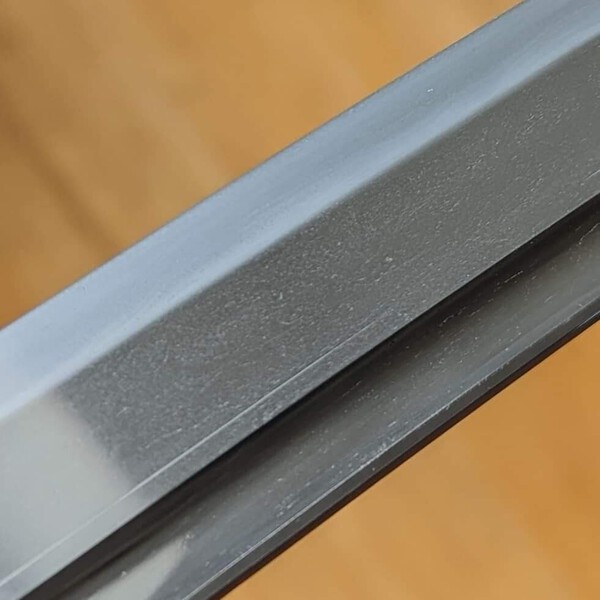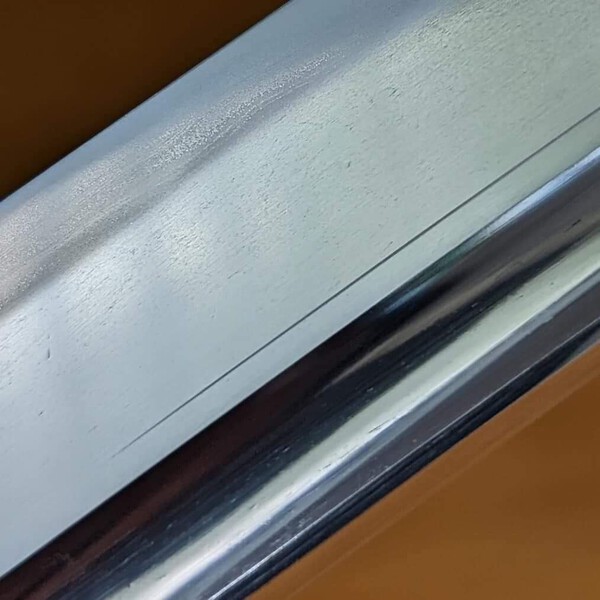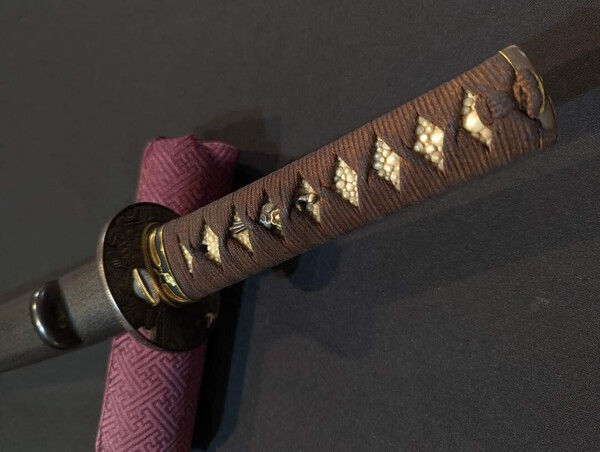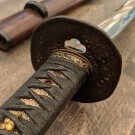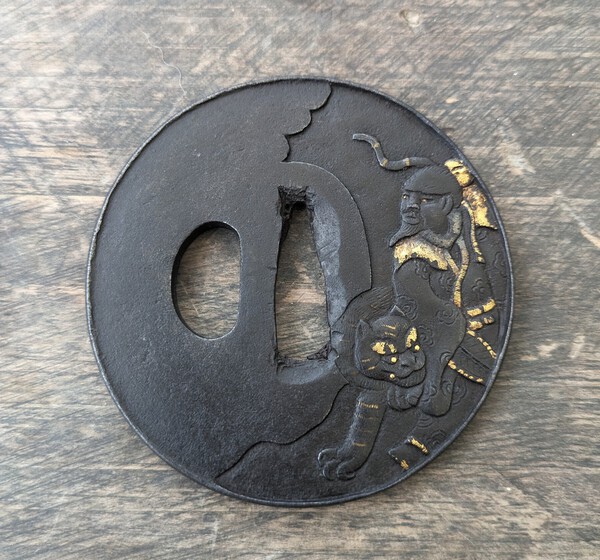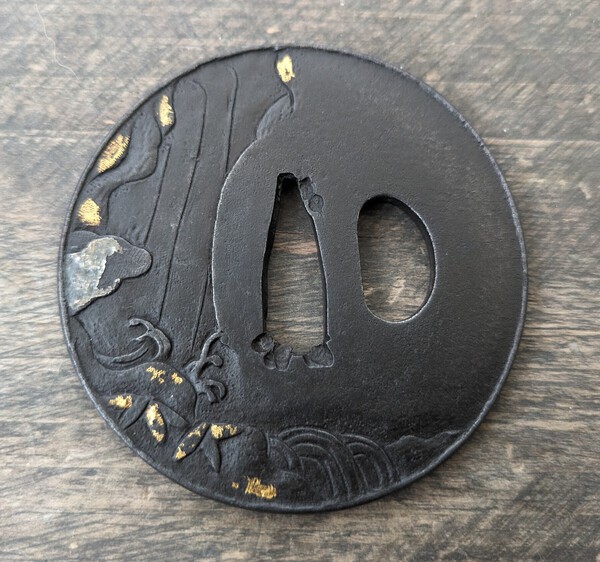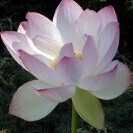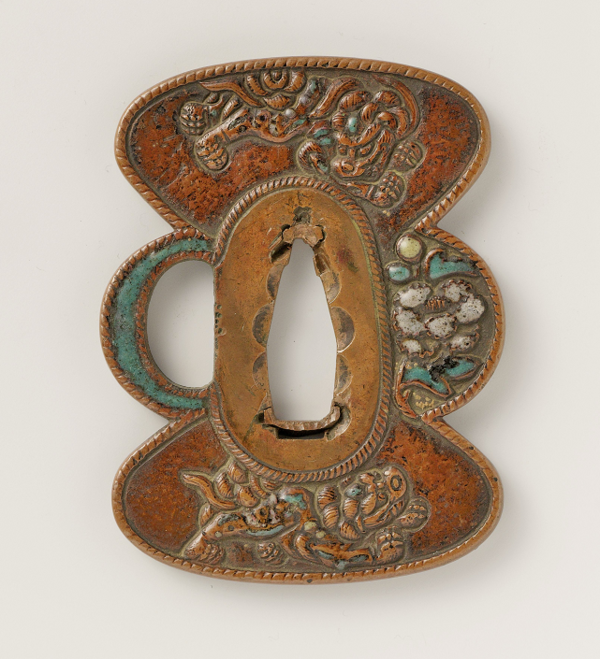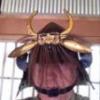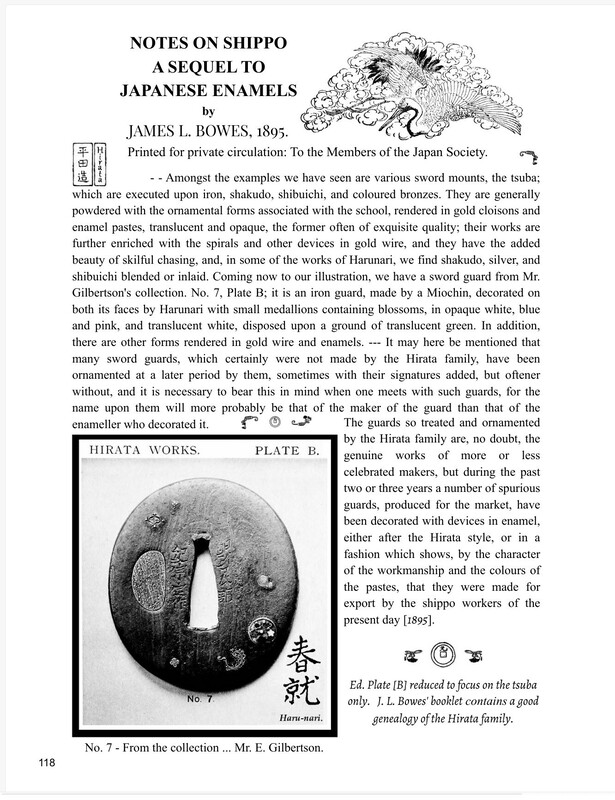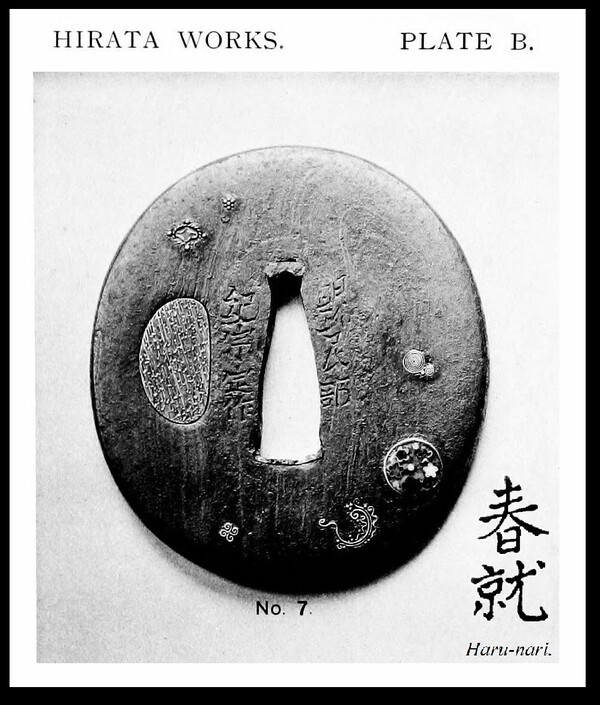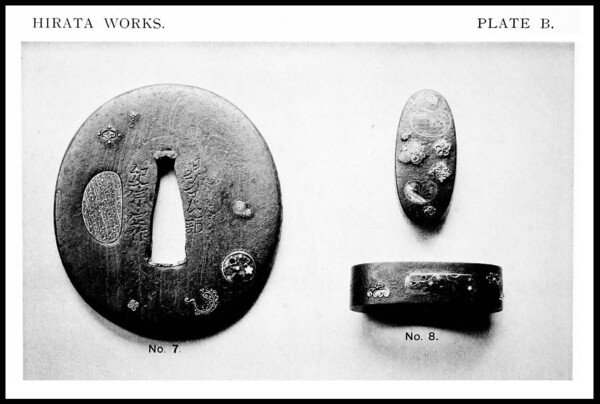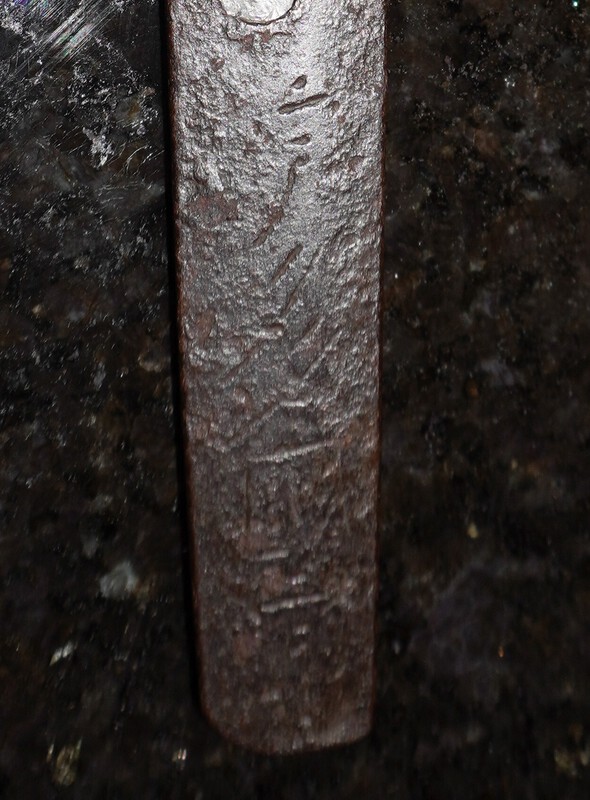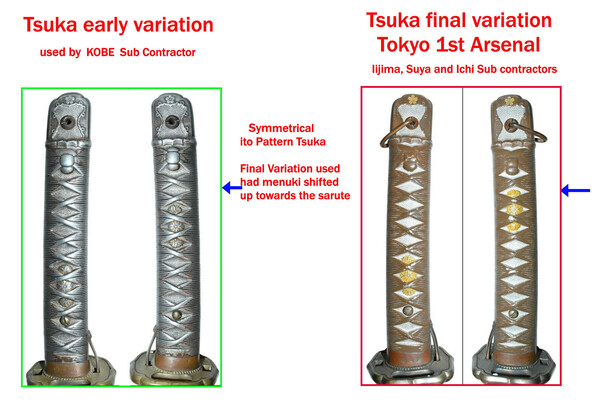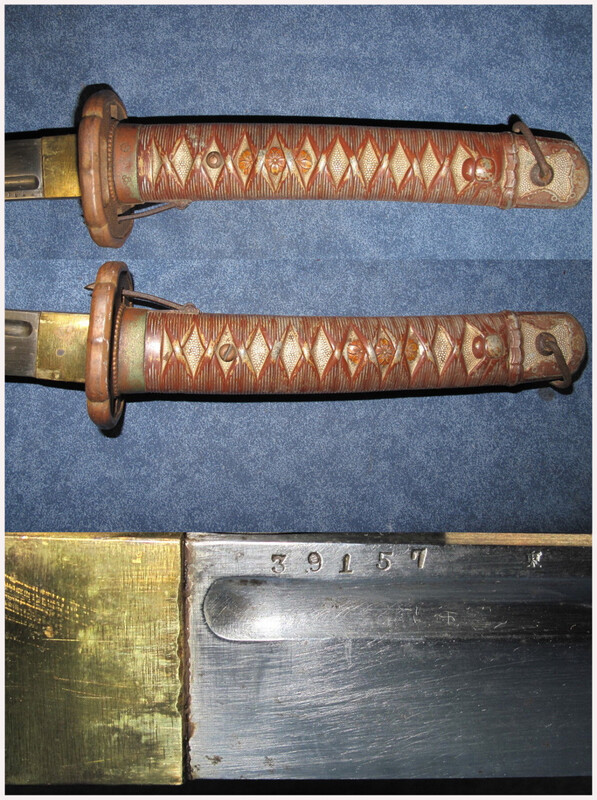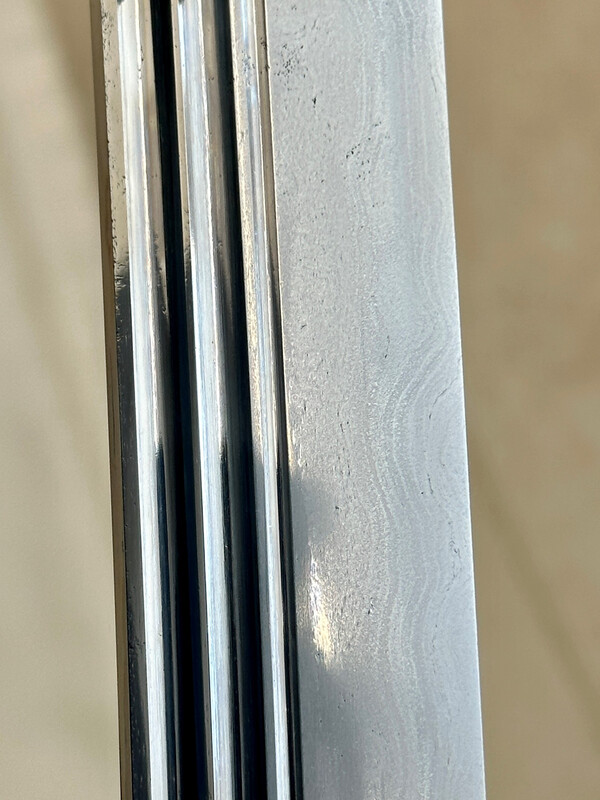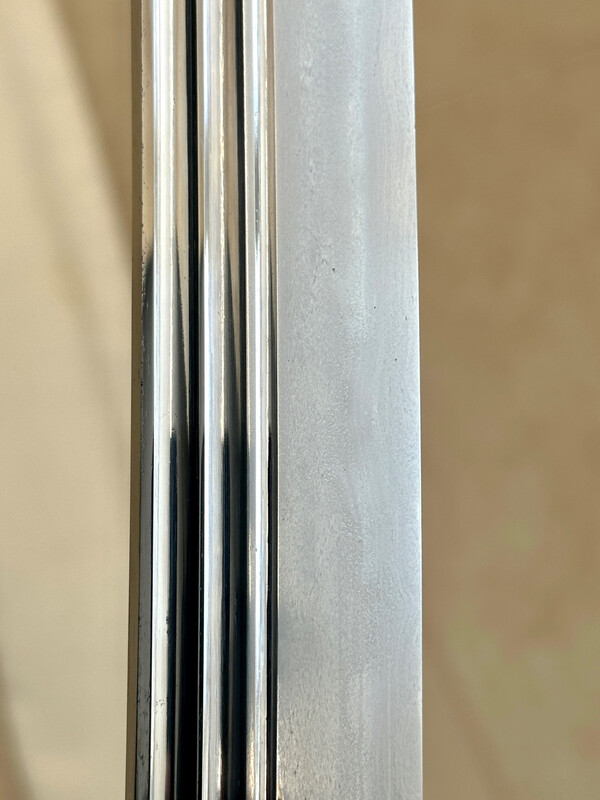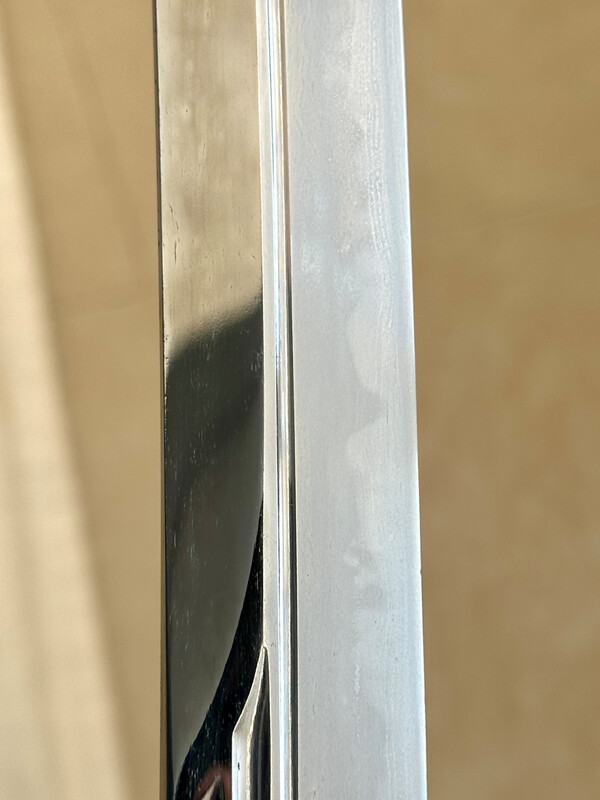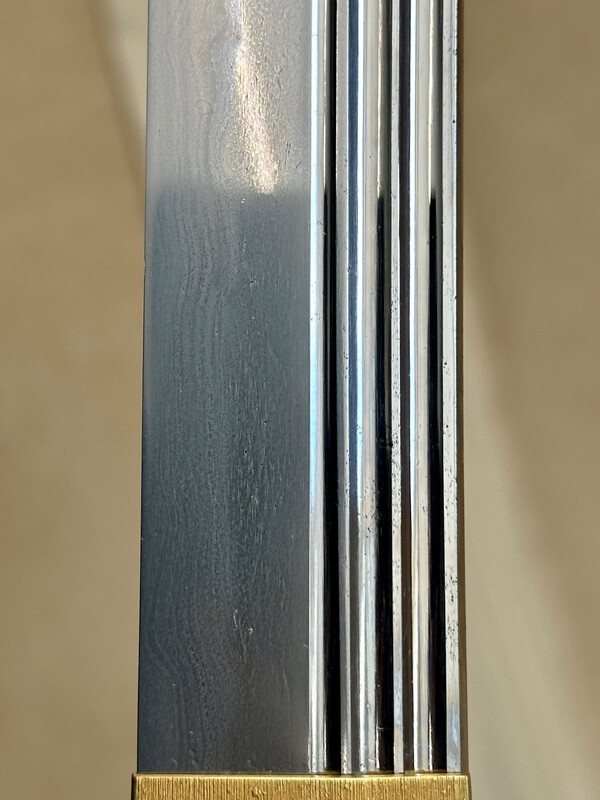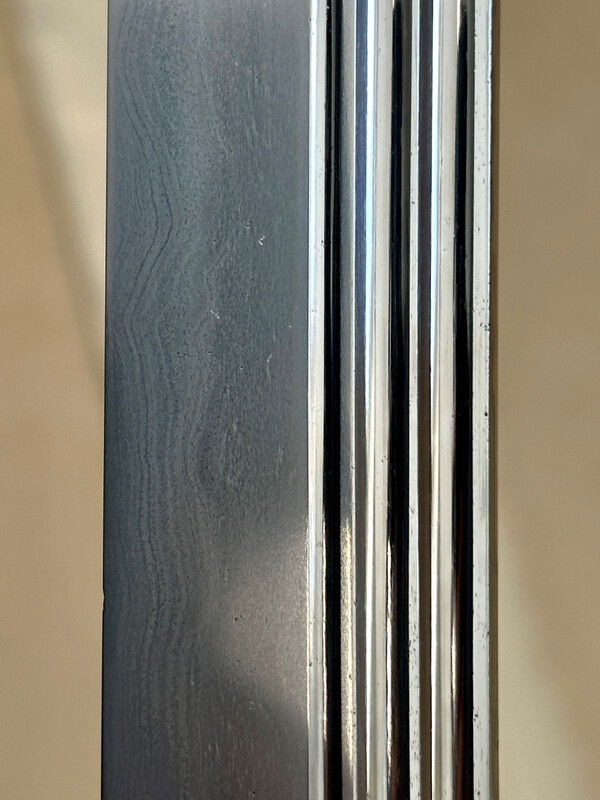Leaderboard
Popular Content
Showing content with the highest reputation on 03/08/2024 in all areas
-
Hello Andrew, I've got good news and bad news: The bad news: I'm afraid this isn't a WW2 sword. The good news: It dates from several centuries before WW2, potentially from the 1600s. The inscription is 近江守藤原継 (cut off) Ōmi-no-kami Fujiwara Tsugu... (cut off, but probably Tsuguhiro) It means 近江守藤原継廣 Ōmi-no-kami = Lord of Omi Province (Omi province is present-day Shiga Prefecture in Japan. Fujiwara = this is a clan name. Not really to be taken as a literal name of the swordsmith. Its the swordsmith declaring he has a lineage to an ancient aristocratic clan. Tsuguhiro = is the swordsmith's name. Not his real, given name, but more or less a professional name. Your sword was originally longer by a few inches, but it was cut down at some point. Shortening the sword is very common. It was always shortened from the tang. So the tang was shortened, and the notches where the brass collar sits were moved up. Could have been done a couple of hundred years ago, or a hundred years ago. There are many swords with fake signatures, and yours too could have a fake signature. Faking signatures was (and still is) very common. Regardless, the sword itself is still a genuine Japanese antique, and could still be several hundred years old even if the signature turns out to be fake. So what I'm saying is, the sword should be preserved, shouldn't be subject to any amateur restoration efforts, and is probably worth showing to someone who knows a lot about swords. It will be hard to authenticate it just by looking at photos. And, the condition probably precludes anyone from making an accurate assessment. But, as I said, the sword is a genuine antique regardless of the authenticity of the signature.7 points
-
Nambokucho O-Suriage Tachi NBTHK Tokubetsu Hozon to Shikkake school One of the 5 schools of the Yamato Den 71.2 cm with a 23 cm Nakago. This would have been a massive Tachi before O-Suriage . Solid gold Habaki Sayagaki by Mr. Tanobe : This sword is O-Suriage museum.The omote shows an itame mixed with Nagare and Madame. The ura side features some ji-nie.The hardening in suguha is nie- laden and is interwoven with uchinoke and got sure, and the hakikake in the Boshi. We reorganize the characteristic features of the Yamato tradition the connected gunome that appear in places resemble doe-yakiba ,with that this masterwork can be attributed to the Shikkake school. 20214 points
-
The residue might be cosmoline, or might be some old oil. Either way, I would remove it from the sword with denatured alcohol and a soft cloth. If you have any lens-cleaning cloths (like for cameras or glasses), those will work very well. Clean off the old oil, then put a very thin layer of lightweight oil (sewing machine oil or electric shaver oil) on the sword to stop it from rusting. You don't need to drench it in oil. A tiny film of oil will be fine. The wooden scabbard (called a shirasaya) is a plain scabbard used for storing the sword, and they are still made and used to this day. We all store our swords in them. Yours is well past its "use by" date, so at some point you should get a new one made. (You don't want an antique sword resting in a scabbard that has a hundred years of old grime and oil and dust and muck in it). If yours is clean inside, and just has tape residue on the outside, it should be OK to continue using for now. Also OK to tape it back up so that it actually works as a protective case for your sword. These things are meant to be renewed when they start getting dirty and falling apart. If it has some old writing on it, you'll want to preserve it, but if its just a plain, dirty, wooden scabbard that's falling apart, it's OK to tape it back up and use it until you can get a replacement made. The sword looks to be just under 24 inches from tip to notch, so it's right on the border between "wakizashi" size and "katana" size. These are the official size designations used by Japan today. Anything over 60.6 cms is classified as katana, and anything 30.3 cm - 60.6 cm is classified as a wakizashi.4 points
-
4 points
-
Yes, If the sound you are referring to is the lovely silence of blade sliding on wood, then we understand! But if you mean Hollywoods notorious "Schwingggg", then that, my friend, is pure fiction. This is the only diagram I have, there may be better one's out there: Here is a photo of one of my mantetsu with the liner out.3 points
-
3 points
-
3 points
-
Dear Joseph. If the crack is sharply defined, almost geometric then be concerned. If it meanders then it might well be a forging lamination that you are seeing and no cause for concern. All the best.3 points
-
This is a quite spectacular and healthy koto daito with Tokubetsu Hozon papers to the late Nanbokucho / Oei smith Hokke Ichijo. The blade just received an exemplary restoration in Japan, with high quality polish, shirasaya and gold foil habaki. The blade has a bright suguha based hamon with lots of fine activities along the edge. The jihada is a beautifully formed itame with a few areas of flowing itame and masame. In shirasaya with WWII era shingunto koshirae with leather cover. A good choice of someone is looking for an example of the highest quality of blade that can be found in koshirae carried to war. ICHIJŌ (一乗), 1st gen., Ōei (応永, 1394-1428), Bingo – “Bingo no Kuni-jū Ichijō saku” (備後国住一乗作), “Hokke Ichijō” (法華一乗), “Bingo no Kuni-jū Ichijō” (備後国住一乗), “Ichijō” (一乗), “Ichi” (一), he lived in Kusado (草戸) in the Ashida district (芦田) of Bingo province, because of that local connection, this lineage is also referred to as Ashida-Mihara (芦田三原) or due to the supplement “Hokke” also to as Hokke-Mihara (法華三原), some sources see him as son of Mihara Masaie (正家), others as student of Kokubunji Sukekuni (国分寺助国), beautifully and finely forged ko-itame, suguha mixed with gunome-midare or chōji-midare, jō-saku $10,500 + shipping3 points
-
I wanted to test the water so I put a few tsuba in an UK auction on Tuesday 12 March 2024 at 9.30am Obviously with buyers and seller costs it dramatically affects the original price so I'll see what happens My tsuba are lots, 132 to 141 and the link is below: https://www.sworder....&sd=0&pp=96&pn=2&g=12 points
-
2 points
-
2 points
-
2 points
-
As a quick follow-up to this topic. I contacted Elliot Long, and he shared the photos of this tsuba with Robert Haynes directly. They have both confirmed that my tsuba is a 'wide-spaced' Nobuie ID# H 07074.0. https://www.shibuisw...com/nobu----iye.html2 points
-
2 points
-
2 points
-
There are two wooden liners in the military metal saya. I had a beautiful and rather unusual Shin-Gunto katana, and when I took the liners out they were absolutely covered in kanji. Unfortunately I never got round to translating them, somethinbg that I deeply regret.2 points
-
Excellent find Dale! If someone can work on a translation of that, I think that's your answer. It is too similar to not be related. I suspect this is the same age and history of the one under discussion.2 points
-
2 points
-
I don’t see a crack in the boshi. What you’re seeing on the mune is burnishing (nagashi), which is part of the polishing process.2 points
-
I bought this tsuba in a UK auction fairly recently because I liked the style and subject matter (who doesn't like a tiger?), but I actually don't know anything about it, and I'm not sure where to begin looking for the school/age/maker/etc. It is a shame its lost a bit of its gold and silver leaf, but I'm a big fan of iron anyhow - and it is actually my first tsuba that I bought that wasn't either attached to a sword or heavily rusted and in need of rescue. By the way, is there a reason the nagako ana has been shaped so much? Does that imply its been fitted to multiple different swords in the past? As always, any thoughts good or bad are welcome, George1 point
-
1 point
-
Reworked - that's interesting. Could explain the variation in how the roman numbers were written. John C.1 point
-
Sam, Rob probably has more experience with them than me. That one with the butterfly lock/notch at the end was unique. Most of them have smooth ends that simply, like Russ said, slide in and out. Rob could tell you what type of wood they used too. I know it's been mentioned on various threads.1 point
-
Hmmmm……I doubt that’s for “one of the great Tokugawa families” . Solid gold seppa…..doubtful? It does clarify the construction method which is interesting. Date??…..more likely to be late than early?? Not all old books are totally accurate maybe? Great find @Spartancrest1 point
-
Many blades are copies of earlier styles. Study the history. Time to build that nihonto library. https://studyingjapa...tag/kannmuri-otoshi/ Regards,1 point
-
John, I love that bread knife. I have a decent one that I bought from JCK, but seeing yours makes me want to upgrade....1 point
-
Save the dates - the NTHK 2024 East Coast Shinsa is coming to the Orlando Sword Show in June - get your valuable swords and fittings appraised by a team of Japanese experts - https://nthkamerica.com1 point
-
Nioi deki or nie deki is not the only criterion to be taken into account in determining a sword's effectiveness. The architecture (shinogi or not), the length, the width and finally the thickness must all be taken into account.1 point
-
1 point
-
Some years ago I asked around for someone here in Japan to make me a shirasaya. Among the replies was one which surprised me. "Why don't you make your own?" "Must be joking!" I thought, but this person was serious. Since then I have paid more attention to shirasaya in general, and although most are beautifully created, many of them do indeed, judging by the material and shape, look to be homemade. (So not totally impossible. I would want to learn how to do it first, though, if ever I were to try my hand!)1 point
-
Just a note - don't buy any images through Alamy - they use public domain material which is freely available if you know where to look. In this case the Rijksmuseum in Amsterdam. https://www.rijksmus...llection/AK-MAK-1135 Another from the same museum https://www.rijksmus...llection/AK-MAK-1128 [Besides I did the book on this museum ]1 point
-
Morning all, Just thought I would give an update on the sword. Andrew has appraised the sword and i'm happy in one way but also un-happy in another. I have decided to share the full appraisal becouse I do love fact finding and shareing information. What I'm happy about, I have found out more about the sword and it has come from a professional in the field. What i'm un-happy about, I would still like to get the sword a Polish a Habaki and Shirasaya, Andrew did not want to do this for my sword. He has advsied it's not personal and I respect that, I can only assume that he does not see it as worth his time. That however does not help me with my goal. I still want to do this for my sword. Spending money even if it does not add to the value is fine with me. As I still want to display this sword and also protect it more than with a newspaper saya. Would anyone have any suggestions or options?1 point
-
There are a number of tsuba decorated by the Hirata school that are signed - however many of the tsuba were signed by the tsubaco [tsuba maker] not by the decorator, so it is possible that cloissone work can be signed by almost anyone. NOTES ON SHIPPO A SEQUEL TO Japanese ENAMELS by JAMES L. BOWES, 1895. Printed for private circulation: To the Members of the Japan Society. - - Amongst the examples we have seen are various sword mounts, the tsuba; which are executed upon iron, shakudo, shibuichi, and coloured bronzes. They are generally powdered with the ornamental forms associated with the school, rendered in gold cloisons and enamel pastes, translucent and opaque, the former often of exquisite quality; their works are further enriched with the spirals and other devices in gold wire, and they have the added beauty of skilful chasing, and, in some of the works of Harunari, we find shakudo, silver, and shibuichi blended or inlaid. Coming now to our illustration, we have a sword guard from Mr. Gilbertson's collection. No. 7, Plate B; it is an iron guard, made by a Miochin, decorated on both its faces by Harunari with small medallions containing blossoms, in opaque white, blue and pink, and translucent white, disposed upon a ground of translucent green. In addition, there are other forms rendered in gold wire and enamels. --- It may here be mentioned that many sword guards, which certainly were not made by the Hirata family, have been ornamented at a later period by them, sometimes with their signatures added, but oftener without, and it is necessary to bear this in mind when one meets with such guards, for the name upon them will more probably be that of the maker of the guard than that of the enameller who decorated it. The guards so treated and ornamented by the Hirata family are, no doubt, the genuine works of more or less celebrated makers, but during the past two or three years a number of spurious guards, produced for the market, have been decorated with devices in enamel, either after the Hirata style, or in a fashion which shows, by the character of the workmanship and the colours of the pastes, that they were made for export by the shippo workers of the present day [1895]. [ed. J. L. Bowes' booklet contains a good genealogy of the Hirata family.]1 point
-
@Shugyosha John J. thanks again for your support and additional information. @Geraint Thanks for the helpful weblink. I remember reading it a while back but at the time I didn't have a wide mei Nobuie tsuba examples in my collection. Therefore, my study was not very tangible. Here is a photo of my new tsuba I picked up at 2023 DTI. It was unpapered and affordability priced as the NBTHK consider all wide mei Nobuie tsuba as having a fake signature (gimei 偽銘). (This might have changed so please correct me if I am wrong.) Notice the wide placement of the Kanji at top and bottom ends of the (seppa-dai 切羽台) area.1 point
-
Here's your man for any restoration questions in Oz. https://touken-togishi.com/1 point
-
1 point
-
Good job taking notice of this Conway! I second Kippu's comments that this is 'right' inside the Kobe serial number range, it is now the second of it's type (with brass tsuba) that has surfaced. The serial number range before Kobe (37k-39k) is from Gifu, and Suya continues on after this range. However, i'd be a bit cautious buying this sword personally. If you are after a Kobe example, i'd pass on this one, regardless of the serial number. Looking at the other pics from the Auction, i can see that the handle is different to all the other Kobe examples on file. It has the final variation of the Symmetrical Aluminium handle as used by the Tokyo 1st Arsenal, this doesn't automatically exclude it as original though. This version had the left side menuki repositioned higher up towards the sarute by one cross in the ito wrap pattern. Look at the pic below to see what i mean. This pattern also appears sporadically in the lower serial number ranges, giving credence to the idea that these may have been repaired at some point. I have only one on record with an Ichi fuchi in this serial number range, it is 39157, at the end of the Kobe serial number range. It also had Brass tsuba, and this is the highest recorded number i have. It is also a bit cleaner of an example than this one and appears to be a more honest or genuine in my opinion, see below. Bruce you could be spot on with both comments as per repairs and the connection that Ichi and Kobe are of the same shop. The 39157 example being the highest, may provide evidence of this. With Ichi taking over from Kobe, parts such as the fuchi may have been used when the original kobe fuchi's had run out. I believe this may have occured, otherwise they could both be examples of shop repairs which we know did happen.1 point
-
With Ern's permission, I'm pasting a post he made on this Wehrmacht-awards Thread discussing certain aspects of the copper-handled version: "These began production in 1937 and yours is from the final year of production 1938 where the bulk of these were produced before updating to the Aluminium handled version. An ordnance order was issued during production which began to address issues being reported in the field, such as the loosening of the handle amongst several others. These issues were addressed by the Arsenal in house, with all 'new' continued production and field returns which came in for repair to the arsenal as field repair units may not have been on hand. The handle on this first pattern is only held on by the barrel nut and screw at the end of the pommel where the tassel ring is fitted. The extra screw in the middle of the handle was part of the upgrade in the new Aluminium model being produced, and was an integral part of any Arsenal rework being performed as per the ordnance order. Now for a bit of a background, the copper handles are 'asymmetrical' in design. The imitation wrap simulates what would be seen in real life, so each side differs, especially at the base where it mates up to the locking mechanism and guard. One side is actually not providing as much support, and over time loosens and begins to rattle (your 2nd picture). The introduction of the screw in the middle of the handle addresses this issue, of course the handle is removed and a hole is drilled into the tang of the blade to accommodate this. With the handle being asymmetrical, the hole in the handle drills into the center of the imitation wrap on one side, and in the top of the bridge of the wrap on the other. The result is that the screw protrudes into the hand of the user on one side and it is recessed on the other (see your first two pictures). The screws are made of soft copper/brass and have a tendency to break. The same moulds were used to produce handles in the Aluminium model, for a production run of about 3000 more swords, before new moulds were utilised to produce 'symmetrical' handles where both sides appear the same with the imitation wrap. The mounting position of the new screw was moved a few mm to utilise the gaps of the wrap where the screw being fitted would mount and be slightly recessed on both sides of the handle. Looking at the scabbard, i can see that the retention screw for the throat is missing. Ask him to provide pictures of the scabbard as well. The 'normal' scabbard for this first pattern is fitted with a brass plug only, the more common drag comb is seen on all subsequent models. However, the ordnance order actually addressed this issue as well, and specified changes to the scabbard drag, so to utilise existing stocks of scabbards, drag combs were brazed on to existing brass plug scabbards for a short time. All subsequent production had no brass, but had the metal drag comb fitted instead. You may have either: a scabbard which is the correct type for this first pattern (brass plug for a drag) a scabbard of the correct type with a drag comb fitted (only know of two such in existance), or a scabbard from later production no brass but has drag comb fitted as standard construction. In either scenario, you have the wrong scabbard throat with no retention screw for it. The extra numbers on the blade above the collar appear in a short sequence of production. Some people thought they were army supply/issue numbers linked to specific soldiers, as was the case with German SA or SS daggers for instance. A materials shortage began to be felt at this time and swords for officers were in shortage. The IJA implemented a rental plan for officers to whom a sword was considered as essential kit, the option to buy outright was also in place. The sword in topic here was the type 95 NCO Arsenal issue. Still no records have been discovered linking officers to swords via serial numbers or 'issue' numbers. It is believed by some collectors and researchers that they are rework numbers of some sort, however, it is still not conclusive as to exactly what they represent. Many here may remember Nick Komiya who made many informative posts in this forum some years back, Swords were not his primary field of interest but we eventually wore him down after numerous requests, and what he uncovered in the Japanese archives was pure gold to all sword collectors worldwide. This type 95 model sword, the first pattern being the copper handled version WAS a complete replacement for the previous type 32 model (single handed saber) coming in two versions (short and long). This streamlined supply and production for the war effort in Japan. Nick disclosed that an order had been placed to convert some 1000 or so swords from type 32 configuration to the new type 95 configuration, this was a complete rework so that in the end the converted swords were practically indistinguishable from the new production run of the type 95's. Also the extra numbers (2546 in this case) are only found on the last 1000 or so Copper handled type 95's, not on any of the next Aluminium handled versions which followed. There is no discernable pattern to the numbers in relation to the stamped serial numbers on the blade, they appear to be completely random. In addition, the first half of the stampings are also found with a preceding ホ stamp. Some have been found on the reverse of the blade, others only seen when the habaki (brass collar) is removed. As this all occurred at about the same time, it is my personal opinion that there may be some connection here with these numbers and the re work order in place. There is no concrete evidence to support this yet and further research needs to be done. I hope this sheds some light on these for you, and am happy to try and answer any other questions if i can. Cheers Stegel"1 point
-
Think it's time to start putting some pressure on my boss to send me to SHOT Show 2024. Then I get to attend this show afterwards. Hmm....need to pick up some new agencies. May very well be possible.1 point
-
The blade is so full of life and well polished that actually you don't even need special light nor a good camera since the details are visible anyway. Attached are a few pictures I did only with daylight and my mobile phone. Depending on the angle in which you hold it to the camera you can see different details of the blade. Additionally these made visible a detail which the togishi choose to do - to remove absolutely as minimal material as possible and rather leave a very few rust pits and chips rather than to take away too much material, yet the result is fantastic. The three hi are fantastic and satisfying to look at. Especially for me since I absolutely love them for being perfectly parallel and mirrored on both sides of the blade. Notice the blade cross section changes to diamond shape in front of the hi just to go back to wedge shape (oh year, I know I'm using the wrong terms!) towards the tip.1 point
-
Simon, I appreciate your thoughts and recommendations, especially given your personal experiences I also can feel what you subly are suggesting to me. So also let me be honest: my feeling is that I already got more than I ever expected. And I am very thankful for this gift that I truly stumbled upon. Maybe a year ago I read a very old post (or entry? I can't say for sure) of Darcy Brockbank where he told the story of a Nihonoto collector who has a very high end blade, but only papered Hozon. To now summarize it in my words, simply because it confirms the signature is original, and that was enough for this collector, he got what he wanted. This made me think way more than it probably should. The result was that I noticed the certification at higher level, while it does honor certain pieces, is, at least it appears to me, a truly part of Western culture - to "win", to put something "at highest level", to "compete" with others. If you though look at a blade from an isolated point of view the Hozon or Tokubetsu Hozon papers are way more important, because (if signed) they verify the (signature of the) blade, whereas (to my understanding) Juyo is way more often seen as an award. Additionally (and mentioning it again), does a Masayuki/Kiyomaro blade absolutely need Juyo? Now doing the comparison/competition that I just doomed: for a lot of other smiths the fact if they are Juyo or not make a huge (especially value-wise) difference for them. Blades made by Masayuki/Kiyomaro are, from what I learnt and got told during my journey, somewhat flying above this. So even from this view, unless you have set certain collection limitations such as "Juyo only" or are a "certification junkie", it does not make this much of a difference. If you by now wonder based on the above why I even bothered to submit to Juyo, the answer is pretty simple. Because it already was in Japan, and because you nevertheless try, when the limits for the preconditions are low. Yes, sure I could wait and submit it next year again. And the following year. From what I gathered the chances that one day a blade (fulfilling certain levels of quality) can get Juyo if submitted enough times exist. But what are my advantages of this? In case this really applies, it would simply be a question of time and money until one gets Juyo papers. This to me, given the premise that I'll keep the blade anyway and do not plan to sell it, makes not this much sense whereas for a dealer who is looking/needs to make profit it makes more sense. So my premises are much different and not commercially driven. Finally, I am still young, plus I expect the NBHTK even exist after my death, or at least there will always be some kind of certification of higher level. So if I ever decide I want to go for it again, then there will always be possibilities for this. Even for my descendants.1 point
-
I was informed today that its submission to the 68th Juyo Shinsa was not successful, it did not make it. At first I was a bit disappointed, because it would had been the icing on the cake, but three hours later now I don't feel bad about this any more. It would had been nice to know why it didn't make it - was it the machiokuri they didn't like, any flaws that I had not seen or noticed, or didn't they like the fact that I had the sayagaki added prior to their Juyo shinsa, or would they simply not give out Juyo papers on first submission to Juyo ... I don't know and will most likely never find out. As I though had mentioned in this thread already: I rather have the sword exactly as it is, machiokuri and with cutting test but no Juyo papers than without machiokuri, cutting test but Juyo papers. The cutting test and the obviously old machiokuri tell so much more on its history and add to the item itself what a simple certificate dating 180 years after it was made can never compensate. The best part of this thread therefore is very close: to get it back into my hands. I'll give it another update when this is finally achieved. Oh, and by the way: it will be accompanied back home by the Tachi which the NBHTK attributed to Hokke-Ichijō, so even two items to look forward to.1 point
-
@Tom Darling, please forgive me in advance if this reply sounds rude for myself not being a native speaker of the English language, but your participations in this thread were sometimes very weird and not very helpful for myself. In post #50 you claimed "The habaki ( -0) is original to the nakago, but not the blade. The three (hi) beyond the machi is also a clue"; to my various inquiries what you supposed to tell me and how a habaki can be original to the nakago but not to the blade and which clue the three hi are for you never gave a reply and left others also wondering what you mean. You later then had suspicion it wouldn't make Juyo since it wasn't directly moved to Juyo but instead Tokubetsu Hozon first. Such assumptions make beginners, as I am, uncertain and require me to check back with more knowledgeable persons, such as Markus, who then assured me your thoughts are wrong and everything is alright with my blade and it does the process as it is supposed to be. Subsequently I had requested better pictures of my blade to have something to share with persons that have helped and assisted me with their thoughts and I was eagerly waiting to get them myself, to finally see something more on the blade. You might be correct in that the pictures as uploaded to the forum are not perfect to make judgements on it - I am surely not the one to be able to tell if this picture is perfect or not. But first of all remember that the forum automatically resizes to pictures of maximum 1800 px width/length, plus during this process which also optimizes pictures filesize-wise as well, hence details may be lost. Next, have I had additional pictures, I would had posted them among too. So no, I don't have a full size blade picture of the other side. I'm keeping this forum updated and sharing what I can since many were very helpful and I love the idea of forums especially when it comes to sharing details and items with persons from all over the world for all to give them access to something they might not have and possibly learn from. Finally, no my blade is not the only one known in this style and shape. Darcy on the first page posted one in exact identical style/shape even with also three hi from Juyo 18. You have participated in this thread with several posts, hence you should be aware of this. Now, I don't want you to answer what you meant with the habaki/nakago post nor discuss again the way to Juyo, but mentioned these two things to maybe give you an outside view on how your postings can be understood/misunderstood by others, especially not knowledgeable persons. Therefore (and also because this way I can at least work around the picture size limitation) find attached a cutout picture of the kissaki area that you had particularily asked upon. To my personal astonishment when comparing the kissaki area with a picture that resulted in cleaning the blade (the particular second picture was posted in this thread on page 3 in post #76) it seems they match pretty well, hamon-wise. @vajo thanks for the hint, I missed to address this earlier. I trust the handling person they will give a freshly polished blade proper treatment though so I don't think as a novice I should tell them how to correctly oil and store the blade. It might also just be a few wooden fibers that were in the way when the pictures were taken.1 point
-
1 point
-
1 point
-
It was approx one year until I got confirmation of it being original, that includes export to Japan. From what I learnt quite fast. No idea how long polishing takes, not much worried on this at all. Can‘t go much wrong from now on, quality is more important than speed. And since I‘ve been asked, everything is handled by japanische-schwert-galerie of Germany.1 point
-
I did not have the feeling nor the impression that people in here tried to make me believe my blade was gimei. Some thought this way, some said there are chances. At least that was opposite to the Wehrmacht-Awards Forum where I originally asked. Funnily some members there who in public told me my blade is a Gimei on the other hand sent private messages asking if I would sell it. This did not happen in here and I really enjoyed the discussion since I also learnt some new terms. During all of this process it was very interesting for me to see that most were highly reluctant. Especially if someone like Darcy tells you he does not dare to give an opinion and it should be looked at in Japan, I heard exactly the same from the contacts in Germany from the European NBTHK. The final conclusion of those was that it has differences from known samples, yet all of them said it needs to be looked at at very high level plus told me to go through the risk and hassle to get it to Japan. I've also been told in private by some that most out of Japan and/or without having it in hand would not dare to either call it original or gimei because if Japan said this or that, well then they would in public be the ones that said exactly opposite to Japan. Anyway, all of this encouraged me to get the blade to Japan through a contact in German. I followed all of the recommendations this person gave me, and so far everything was more than 100% correct and I'm highly satisfied with my decisions and really curious to see the result of the polish.1 point
-
Short update since I have been asked several times by members anyway and recently made aware of good news: the blade was sent to Japan and after a very long time it took it to go through customs it was shown to Tanobe san who said the signature is authentic. Then it was submitted (unpolished as is) to NBTHK Shinsa. I have been informed today that NBTHK as well classified the signature as authentic, but for papering they‘ll need to see it polished. So it will now be polished as well as a Habaki and Shirasaya being made.1 point
This leaderboard is set to Johannesburg/GMT+02:00



